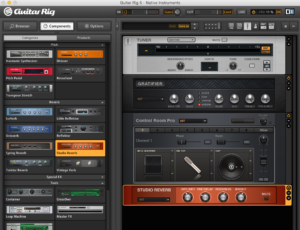The Model Approach
The first time I used software amp modeling it was out of pure necessity rather than personal preference. At the time (somewhere around 2007) I had just graduated to Logic from Garageband and was in a living situation where I could not crank an amp without it leading to an angry knock at the door. So, I played around with the built in guitar amp plugs for that version of Logic and found something that was a least a step up from the DI signal. But, I was never really satisfied with how the guitar sounded and figured I would always need to mic my amp in order to get tone that was tasteful enough to record.
Little did I know at the time, but in a few years I would be relying almost exclusively on amp modeling for studio tracking my music as well as my clients. While none of the virtual amps offered through Native Instruments Guitar Rig replicate exactly the sound of my 1976 Silverface Vibro Champ, this plugin gets me far closer than I was able to with that (now dated) version of Logic. In fact, I find I can get roughly 90% of the way there through some tweaking of either the Fender Twin or Roland JC-120 models, while maintaining a perfectly clean guitar track underneath.
Now, where the plugin really shines is in how easily one can swap heads, cabinets, microphone types and positions, and knobs after recording. Sometimes, a setting that I always use with a band live turns out to be less malleable during the mixing process. In the “old days” I would have been faced with a difficult question of deciding whether the part needs to be re-recorded or move forward with a less than optimal guitar sound in relation to the other instruments for the track being mixed.
And, to reiterate, perhaps what makes GR (and other similar plugs) a no brainer for many of us is the total elimination of noise, as you can simply DI and headphone monitor while tracking. This is critical for home recording where walls may be thin and the last thing your neighbors want to hear is 100 takes of a loud guitar solo.
But, even with all these positives going for it, amp modeling it is not always an easy sell to guitar player clients. This makes sense. After all, they have most likely spent hours upon hours perfecting their tone and are justifiably sensitive about letting someone else take the reigns in dialing it for them. But, more that anything, it is probably due a fear of the unknown and a perception that there is no way that a piece of software could reproduce that heavy vintage box they carry around. In these situations, an actual demonstration is in order.

I like to see a band live before I track them. This gives me an indication of whether my abilities and taste line up with theirs and if I can effectively capture what they do. It is also a good time to take note of their setup. In one project I did for the jam band “Canopy”, I knew that the guitarist played out of a Mesa Boogie, so I was fairly certain we could at least get in the ballpark with GR’s Gratifier model. After spending some time explaining the plugin and how it would be used, we played around with the settings until we found something he liked. We then used a combination of his effects and those modeled within the plugin, figuring out which sounded better/worse. In the end, the band played great and the guitar tone on songs such as “Whim” I feel are very close to his live tone.
I enjoy projects like these because they allow me to track a band in their comfortable practice space without the necessary step of isolating amps. In most cases, I like to keep the option open to record the guitar the traditional way if we fail to replicate the tone. In spaces where this isolation is not feasible, this would require using the modeled signal as a scratch track and then either sending it through a mic’d amp or doing an overdub with that amp.
Interestingly enough, it has been my experience that bass players are less resistant to amp modeling, perhaps because they have grown accustomed to DI-ing and doing most of the tone’s heavy lifting through EQ, but I am not sure. Further, while the benefits of modeling in the studio are great, I have encountered issues with using them live that may outweigh the benefits, depending on your personal preferences.


Comments
The Model Approach — No Comments